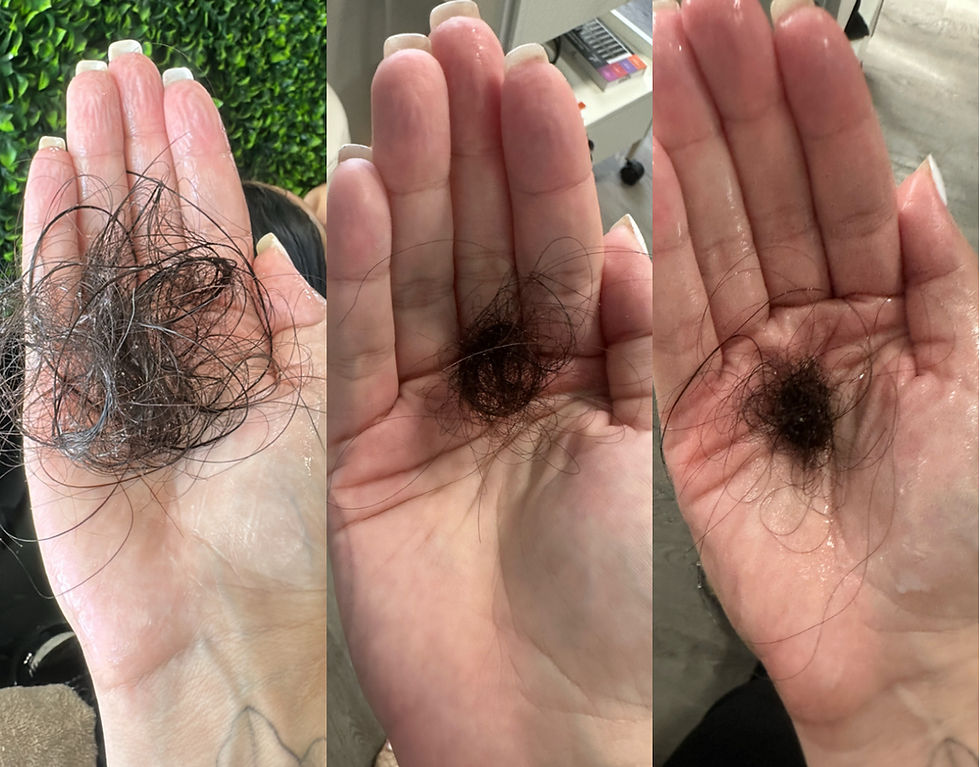The Harmful Effects of Smoking on Hair Health
- Taluani Rivafelis
- Oct 9
- 3 min read
Smoking doesn’t only harm your lungs — it silently damages your hair, scalp, and follicles from the inside out.

When we think about the harmful effects of smoking, the first thing that comes to mind is usually the lungs or heart. However, few people know that smoking can also silently and progressively harm the health of your hair and scalp. The damage doesn’t happen overnight — it builds up over time, affecting the hair follicles from the inside out, and leading to visible changes in hair quality, density, and scalp balance.
Below, you’ll understand how smoking impacts each part of your hair system, and why addressing it early is essential for healthy regrowth and long-term scalp recovery.
1- Reduced Blood Flow to the Scalp
Nicotine constricts the blood vessels responsible for carrying oxygen and nutrients to the scalp. When this microcirculation is compromised, the follicles receive less oxygen, iron, zinc, and essential vitamins — all of which are vital for cell regeneration and healthy hair growth.
Over time, this poor circulation weakens the follicles, shortens the growth phase (anagen), and increases the number of hairs entering the shedding phase (telogen).
2- Oxidative Stress and Free Radical Damage
Cigarette smoke contains more than 4,000 toxic chemicals, including heavy metals such as cadmium and lead. These compounds produce free radicals, which attack the cells of the hair follicles and cause oxidative stress.
This cellular stress damages the DNA inside the follicle, leading to premature follicle aging, hair thinning, and slower regrowth. The result is fragile, lifeless strands that easily break and lose shine.

3- Hormonal Imbalance (Increased DHT Levels)
Smoking also affects the endocrine system by increasing the activity of 5-alpha-reductase, the enzyme that converts testosterone into dihydrotestosterone (DHT).
High levels of DHT shrink the follicles, progressively reducing hair diameter until growth stops completely — a process known as miniaturization. This mechanism is directly related to androgenetic alopecia (male and female pattern hair loss).
4- Impaired Collagen and Keratin Production
Healthy hair depends on proteins like collagen and keratin, which give it elasticity, shine, and resistance. The toxins from cigarettes interfere with the natural synthesis of these proteins and reduce the absorption of key nutrients such as vitamin C, B-complex, and amino acids.
As a result, the hair becomes dry, porous, brittle, and more prone to breakage — even with regular use of professional products.
5- Inflammation and Scalp Disorders
Smoking doesn’t just affect the follicles; it also damages the scalp’s protective barrier. Reduced blood flow and toxic accumulation increase inflammation in the sebaceous glands and surrounding tissues.
This can trigger or worsen scalp disorders such as seborrheic dermatitis, dandruff, folliculitis, excessive oiliness, and even psoriasis flare-ups. The scalp becomes more sensitive, itchy, and often develops micro-injuries that compromise follicle health.

6- Premature Graying
Smoking accelerates the depletion of antioxidants — especially vitamin C and E — that protect melanocytes, the cells responsible for hair pigmentation. Without this protection, melanocytes die earlier, leading to premature gray hair and loss of natural vibrancy.
Research shows that smokers are up to four times more likely to develop early graying than non-smokers.
7- Overall Scalp and Follicle Imbalance
Chronic exposure to cigarette toxins disrupts the scalp’s natural microbiota, oxygen levels, and sebum regulation.
This imbalance weakens the follicular structure, creating a vicious cycle of inflammation, sensitivity, and hair loss. A scalp exposed to toxins becomes a hostile environment for hair growth. The combination of reduced oxygenation, oxidative stress, hormonal imbalance, and chronic inflammation disrupts the scalp microbiota and damages the follicular structure.When this imbalance is not corrected, it can lead to long-term follicle atrophy and irreversible hair loss.
Clinical Perspective
The good news is that the body — and your hair — has a remarkable ability to recover once the source of damage is removed.Within 3 to 6 months after quitting smoking, many people experience improved blood circulation, better oxygen delivery to the scalp, and a visible increase in hair vitality.
When combined with scalp detox treatments, antioxidant therapy, and customised trichological care, it is possible to reverse a significant portion of the damage and restore the scalp’s natural balance.
If You’re a Smoker Facing Hair or Scalp Issues...
Don’t lose hope ! At Rivafelis Hair & Scalp Spa, we specialise in customised trichology treatments designed to:
Detoxify your scalp from accumulated toxins
Restore microcirculation and follicle oxygenation
Rebalance the scalp’s microbiota and sebum production
Strengthen the hair from the inside out
Each protocol is personalised according to your scalp analysis, health history, and goals.
Book Your Consultation
If you’re a smoker experiencing hair loss, dandruff, scalp sensitivity, or thinning, come talk to us.
We’ll help you recover your hair and scalp health through natural, clinical, and evidence-based care.
Rivafelis Hair & Scalp Spa – South Brisbane
Book your consultation today and start your recovery journey.🌿 Your scalp deserves to breathe again.



Comments